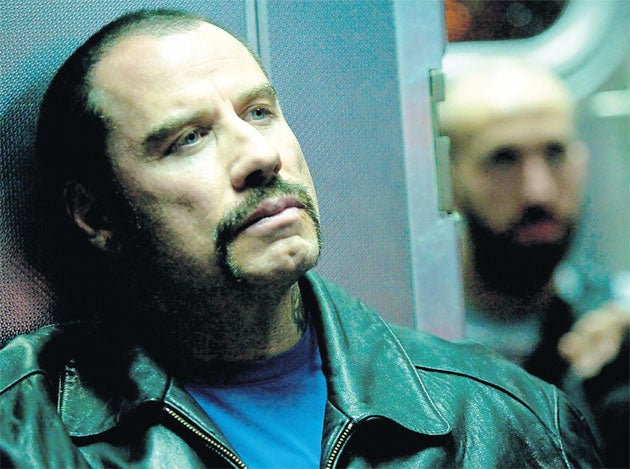The Taking of Pelham 1 2 3 (18), Tony Scott, 106 mins
Starring John Travolta, Denzel Washington, James Gandolfini

Tony Scott movies aren't much interested in subtlety. You know from the first few frames what to expect: the booming soundtrack in full turned-to-11 Dolby, the frenetic pinball editing, the whip-pans and zooms of a camera that can't keep still, the flurry of bangs and collisions that could wake the dead. It's filmmaking on steroids – muscled, brash, in your face.
Ordinarily, this wouldn't bother me. It's like going to the dentist: you hardly feel a thing anymore. But the new Tony Scott movie is different, because it remakes a film from 1974. "Remake" isn't really the word, to be honest. Imagine a favourite old caff with formica tables and vinyl banquettes, run by the same family for generations; then imagine someone flattening it with a bulldozer and dumping, say, a Planet Hollywood in its place. You stand there agog, not quite able to take in the scale of the vulgarity.
It's not that the original Taking of Pelham 123 was a classic, either. It was a rackety-looking thriller shot in the frowzy beige tones that declare its unmistakable Seventies origin. But every part of it, from the script and the casting to the beautiful twist ending, has been made to look vastly superior next to Scott's version. The set-up is unchanged. A gang of hijackers take over a New York subway train, hold its passengers hostage and threaten to kill them one by one if their ransom demand is not met. Denzel Washington plays the subway train dispatcher Walter Garber, on whose shoulders will rest the safety of the hostages; John Travolta plays Ryder, the leader of the gang who talks to him by phone and sets the terms of the deal: $10m, or else.
One could say the film's problems start there. In the original, Walter Matthau played the transit cop whose plaid shirt and hangdog expression were all the armour he needed. Here, it's another of Washington's blameless regular Joes, trailing a back story of corruption charges whose patent untruth is intended to make him look even more saintly. The false modesty of the performance is consistently exposed by people (such as John Turturro's hostage negotiator) telling him what a terrific job he's doing under pressure. Yawn. The case of Travolta, however, is so much worse. He plays this criminal mastermind as a shouty, volatile oaf, forever effing and blinding and threatening to blow holes in unarmed civilians. On the phone he keeps giving away clues about his identity, yet Garber solemnly describes him as "smart". Ryder's back story involves Wall Street trading and jail time on a pensions fraud, though you could hardly imagine this guy selling hot dogs, let alone pensions. Compare him with the gang-leader in the 1974 film, played by Robert Shaw as a tight-lipped, ice-cool killer, and Travolta starts to look like a joke.
The big-name casting reveals a shift in Hollywood filmmaking itself. Scott seems to regard his main work as keeping the stars happy, and so Brian Helgeland's script indulges each man with longer speeches than either character warrants. The consequence is a shortfall of screen time for everyone else. I recall from the 1974 film the other gang members and individual passengers on the hijacked train, the antagonistic relationship between Matthau and the transit controller, the backsliding mayor and his bullying deputy. There's a mayor in the new film, but he's played as a gruff pragmatist by James Gandolfini, importing a post-Sopranos gravitas into a role that should be comic relief. But the New York of 1974 and this film look worlds apart, the former a scuzzy place full of badly dressed men (check Matthau's plain tie and checked-shirt combo), the latter a sleek and busy metropolis where the commuters carry PCs and the subway control room looks like something from Nassau. The talk is all about what "you" can do for New York. A civic pride is in the air.
Now civic pride is no bad thing, but in a film you require some civic texture to go with it. It's typical of Scott that the one set-piece he borrows from the original is a traffic smash: a police squad car carrying the ransom money is roaring so fast down the streets that it collides with a cross-town taxi, jumps spectacularly into the air and thence over a bridge. Why is it that you only ever see things like that in a Tony Scott or a Michael Bay movie? The contrast with Joseph Sargent's direction of the original is informative. Sargent's opening scene focuses upon a man snuffling into a handkerchief – how dull is that? Only it's not, because the man is one of the hijackers, played by Martin Balsam, and his regular sneezing turns out to be a vital clue – the vital clue – in the story's denouement. Gesundheit! Scott abandons this inventive bit of plotting altogether. For a while I hoped, against all reason, that he might have dreamed up something as clever to put in its stead, just as I hoped that Travolta's demented bluster would suddenly be revealed as a brilliant subterfuge. But no, director and star are just as crass as they seem. Silly of me to forget – it's a Tony Scott movie.
Subscribe to Independent Premium to bookmark this article
Want to bookmark your favourite articles and stories to read or reference later? Start your Independent Premium subscription today.

Join our commenting forum
Join thought-provoking conversations, follow other Independent readers and see their replies